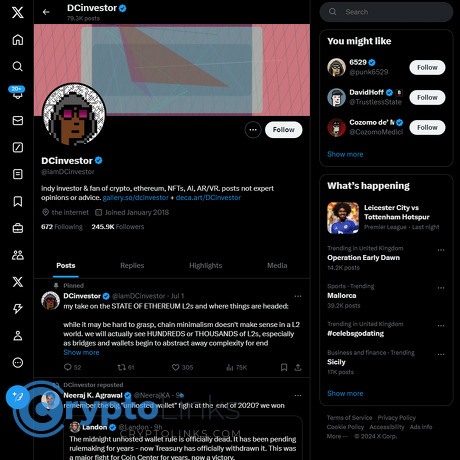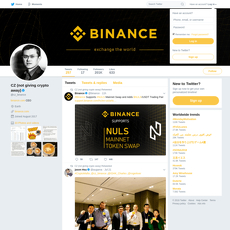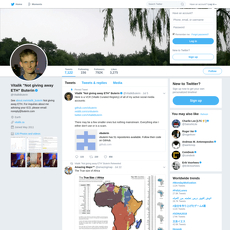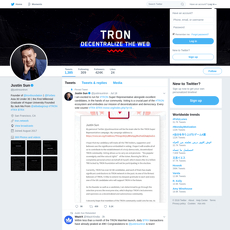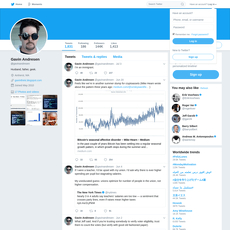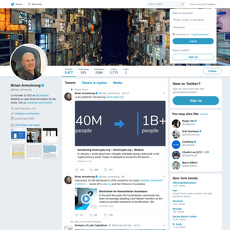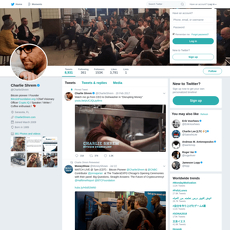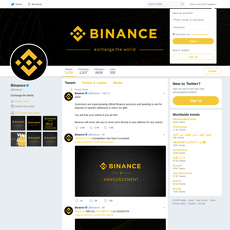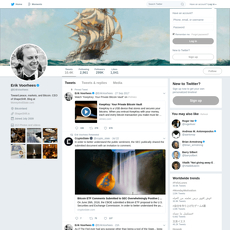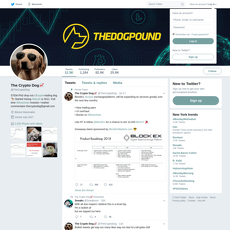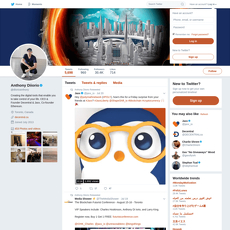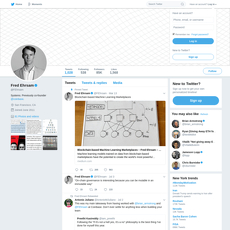DCinvestor Review
DCinvestor
x.com
DCinvestor (@iamDCinvestor) Review Guide: What to Expect, Who It’s For, and How to Use It + FAQ
Ever scroll Crypto Twitter and think, “Is this one of the rare accounts that actually makes me smarter?” If you’re eyeing @iamDCinvestor, you’re in the right place. I’m going to show you exactly what to expect from his feed, who will get the most value, and how to use his ideas without getting lost in the noise. The payoff: you save time, learn faster, and steer clear of common traps.
The problems most people have before following a big crypto voice
Crypto Twitter is crowded. Hot takes are cheap. Good frameworks are rare. It’s easy to get pulled into reactive content and miss the stuff that actually compounds your understanding over time.
You want long-term clarity, not daily FOMO. You also want honesty about risk, bias, and skin in the game.
There’s a good reason to be picky here:
- Noise outpaces signal online. A well-cited study in Science found that false or sensational content spreads faster than accurate information on social platforms. In crypto, that velocity often equals volatility for your attention and your decisions.
- Over-trading kills returns. Barber and Odean’s classic research (Trading Is Hazardous to Your Wealth) shows frequent traders tend to underperform. Feeds that trigger constant action usually aren’t your friend.
- Attention is a resource. UX research from Nielsen Norman Group shows people skim, not read. If an account can’t communicate clearly and consistently, you’ll miss the lesson—or worse, misapply it.
So the goal isn’t “follow more,” it’s “follow smarter.” Look for repeatable ideas, transparency, and a cadence that respects your time. That’s the lens I’m using here.
What I promise in this review
I’ll give you a clear, practical look at DCinvestor: how he communicates, what he’s great at, where his blind spots are, and how to turn his threads into repeatable learnings you can use quarter after quarter.
- Style and strengths: What stands out in his voice and how that helps you learn faster
- Limitations and bias: The places you’ll need to supplement with other feeds
- Content mix: Threads, frameworks, market notes, plus how often he posts and why that matters
- Practical setup: Simple tactics to save and apply his best stuff without getting overwhelmed
- FAQ: The quick answers people ask most so you can decide fast
By the time you’re done, you’ll know exactly how to use his insights without mistaking opinion for advice—or turning your day into a notifications treadmill.
Why listen to me + how I tested this account
I’ve spent years curating the best crypto tools, feeds, and resources for readers who want less hype and more signal. For this review, I looked at his account through a consistent lens so you can compare it to other voices you follow.
- Content type: Are there real frameworks and thesis threads, or just takes? I checked for longer posts that teach—think holding vs. trading logic, network ownership ideas, and how he evaluates protocols over a full cycle.
- Signal vs. noise: What’s the ratio of educational posts to chatter? Does the feed stay useful during market swings, or does it turn reactive?
- Transparency: How does he communicate risk, bias, and any skin in the game? Does the tone stay sober when the market froths up?
- Usefulness by skill level: Would a newcomer learn foundational principles here? Would an intermediate reader deepen their approach, not just add hot takes?
- Balance: Where is he strongest—and where will you want to pair with other perspectives (especially beyond ETH, or in faster trading contexts)?
To make this fair, I sampled recent months and older posts to see how his thinking holds up across different market moods. I also checked how learnable his threads are: Can you bookmark them, write a one-paragraph summary, and reuse the idea in your portfolio process? That’s the kind of content that compounds.
Ready to see whether this is the kind of feed that sharpens your edge instead of scattering it? Up next: who he is, what he’s known for, and whether his style fits your goals—especially if you’re building an Ethereum-first strategy.
Who is DCinvestor and what he’s known for
Short profile
@iamDCinvestor is one of the rare crypto voices who treats this market like a serious, long-term ownership game. He leans Ethereum-first, favors clear mental models over hot takes, and consistently brings the conversation back to security, incentives, and what actually endures across cycles.
“Time in the market beats timing the market.”
That line sums up the energy you’ll find on his feed: less sugar rush, more signal. When everything is green, he talks about risk. When everything is red, he talks about staying power and why network design matters. I don’t always agree with every stance, but I always feel smarter after reading his threads—and that’s the point.
Investing style at a glance
Think long horizon, fundamentals first, Ethereum at the center. If you’re tired of scrolling through the same “what’s pumping” chatter, his approach will feel like stepping into clean air.
- Long-term ownership over trading: He frames portfolios as partial ownership of productive crypto infrastructure, not a bag of lottery tickets. There’s a strong focus on assets that can accrue value from real usage and security budgets.
- Ethereum-centric analysis: Expect repeated attention to client diversity, credible neutrality, L2 maturation, and how staking ties economic security to real yield. That lens creates consistency—you know the criteria he’ll use before the take arrives.
- Staking and “productive assets”: He talks through staking as a way to align with network security rather than chase daily volatility. For context, investor behavior research like Morningstar’s “Mind the Gap” shows that frequent trading often hurts outcomes, while long-term holding narrows the performance gap between funds and the people using them. His style helps you avoid that churn.
- Quality filters for protocols: He stresses durability: incentives that won’t break under pressure, governance that can adapt, a path to sustainable fees, and real users. This stands out when markets reward noise; his criteria stay put.
- NFTs and on-chain art, with purpose: He’s not “mint now, flip later.” He’s about provenance, culture, and the idea that some on-chain art will matter in 5–10 years. Academic work backs that provenance matters in NFTs; for example, research mapping the NFT market finds creator reputation and network effects are core drivers of value (Nadini et al., 2021).
If you want a data point on why this slower, principle-led style can win: S&P’s long-running SPIVA scorecards show most active managers underperform simple benchmarks over longer horizons. Different asset class, same lesson—process and patience tend to beat churn.
Audience fit: who should follow him
He’s a match for people who want to grow sharper judgment, not just collect tickers.
- Builders and researchers: If you care about the trade-offs behind decentralization, client diversity, and L2 design, his threads help you pressure-test assumptions.
- Long-term investors and ETH stakers: You’ll get mental frameworks for allocating, sizing, and staying sane through cycles—useful whether you solo-stake or use liquid staking.
- NFT and on-chain art collectors: If provenance and cultural significance matter to you, you’ll appreciate the way he frames “enduring value” instead of quick flips.
- Anyone allergic to FOMO: If your goal is to learn faster without feeling dragged around by the news flow, this feed is an antidote.
What I personally like: his consistency makes it easier to build your own checklist. Over time, you’ll catch yourself asking, “Is this protocol’s security and incentive design strong enough to survive a full cycle?” That’s a better question than “Will it pump by Friday?”
What he’s not
- Not an airdrop farm guide: Don’t expect step-by-step farming threads or points-chasing tactics.
- Not a meme caller: If you want daily tickers and emoji, you’ll be bored here—and that’s by design.
- Not a signal feed for scalps: You won’t get hourly charts or precision entries and exits. This is principle-led investing, not ping-pong trading.
One more thing I watch for: tone. He doesn’t yell. He explains. In a market that rewards volume, that calm delivery is quietly powerful. It keeps you focused on the work—studying networks, sizing risk, and letting time do the heavy lifting.
So, if this is the kind of voice you keep on your short list, you’re probably asking: what will you actually see on his feed day to day—threads, themes, cadence, and how often he weighs in? Let’s look at that next.
What you’ll actually see on his feed
Core themes
Expect a steady flow of first-principles thinking that keeps your attention on the pillars that matter long after a hype cycle fades.
- Ethereum and credible decentralization: security tradeoffs, validator economics, client diversity, and why safety beats speed when real money is on-chain.
- Staking and productive assets: owning yield from protocol work (not just price swings), plus the practical realities of solo vs. pooled staking and operational risk.
- L2s and real scaling: data availability, proofs, sequencer decentralization, and incentives that make rollups more than just cheaper gas for a season.
- Incentives and governance: token distributions, quorum health, voting apathy, and how power concentrates (or doesn’t) as networks mature.
- Sustainable crypto economics: usage-driven fees, burn mechanics, funding public goods, and how to spot models that survive bear markets.
“Volatility is the price of admission. Clarity is the edge.”
That’s the emotional heartbeat of his feed: less adrenaline, more alignment with long-term ownership.
Framework threads worth watching
When he posts a longer thread, it reads like a compact playbook you can reuse. The common pattern is: define the goal, outline tradeoffs, apply it to current narratives, and show how it fits across cycles.
- Hold vs. trade: a simple rubric that weighs tax friction, opportunity cost, and conviction.
“If I sold today, what would I buy that’s strictly better for five years?” is the core test. - Own the network, not the noise: focus on assets that capture network economics (fees, security budgets, real usage) rather than narrative-only tokens.
- What “quality” looks like: security assumptions, credible neutrality, permissionless access, Lindy, and user-retention signals (not just wallet counts).
- Cycle-aware thinking: map where we are (late bear healing, early bull euphoria, or distribution grind) and adjust behavior, not principles.
There’s a reason this approach works: research in behavioral finance (Barber & Odean, The Journal of Finance) shows frequent trading tends to hurt returns, while sticking to a clear rule-set reduces costly churn. His threads nudge you toward that discipline.
Market commentary cadence
You won’t get play-by-play. You’ll get timely posts when there’s something meaningful—protocol changes, security events, L2 milestones, or a narrative turning point. That restraint matters. Stanford research on multitasking (Ophir, Nass, Wagner) found that constant context switching weakens our ability to filter noise. Fewer, higher-quality posts help you keep mental bandwidth for real decisions.
- During volatility: expect reminders about position sizing, time horizons, and why forced errors happen in panics.
- After big news: he’ll often reframe it through first principles—security, incentives, and who actually benefits over time.
NFTs and on-chain art
This is not a flipping feed. It’s collecting philosophy: why certain works have staying power, how provenance and permanence matter, and what “on-chain” truly means for cultural artifacts.
- Provenance: code and metadata immutability, verifiable issuance, creator track records.
- Distribution mechanics: fair mint structures, scarcity that isn’t gimmicky, and how communities form around art rather than price.
- Cultural relevance: why a piece speaks to crypto’s history or ethos, not just its floor price this week.
It’s a useful counterweight if you’re tired of “quick flip” talk. You’ll learn how to judge endurance, not just momentum.
Debates and strong opinions
He wears an ETH-first lens and he’ll defend it—security assumptions, settlement finality, and the stack’s path to decentralization. The replies often host genuine back-and-forth on:
- L2 design choices: fraud vs. validity proofs, data availability layers, and sequencer decentralization timelines.
- Validator and staking risks: custody vs. solo, operator concentration, and the blast radius of correlated failures.
- Token distributions and governance:airdrops, team allocations, voter turnout, and capture risks.
Read the replies. The best learning is often in the frictions—where smart people disagree and assumptions get stress-tested.
So where does this kind of feed truly shine—and where might you need other voices to balance it out? Keep going; the next section answers that directly, with no fluff.
Strengths and limitations (straight talk)
“In a market that rewards attention, the rare edge is patience.”
When the market is ripping or dumping and your emotions want the wheel, this feed feels like a seatbelt. Not because it calls tops and bottoms, but because it reminds you what actually compounds.
Where he shines
Clear frameworks that age well. Expect posts that separate “ownership” from “speculation,” and why productive assets (like staked ETH) align incentives across cycles. For example, around major milestones like The Merge, his commentary leaned into validator decentralization, security budgets, and key management — the stuff that matters after the headlines fade.
Long-term, ETH-first lens without the hopium. He connects the dots between staking, L2 economics, and governance, then stresses trade-offs. It’s the opposite of “number go up.” That’s useful when you’re trying to decide what to actually hold through volatility.
Culture-aware without becoming a flipper. On NFTs and on-chain art, he focuses on provenance and historical significance (think early on-chain works like Autoglyphs or generative staples like Squiggles) rather than whatever spiked today. If you collect to hold, not to churn, this is signal.
Consistent ethics and a sober tone. No giveaway bait, no “DM to win,” no click-chasing. In a space full of shortcuts, the absence of shortcuts stands out.
Why that matters: frequent trading usually hurts performance. In traditional markets, researchers Barber & Odean found that investors who traded the most underperformed by a wide margin (“Trading Is Hazardous to Your Wealth”). Different market, same human brain. A feed that slows you down is a feature, not a bug.
Where you’ll want to supplement
Coverage outside Ethereum is limited. You won’t get equal time for Bitcoin, Solana, or Cosmos. If you need cross-ecosystem breadth, plan to follow a few specialists alongside.
Not a degen trade hose. You won’t find rapid-fire entries, exits, or airdrop farming calendars here. If you live on 5-minute charts, this stream won’t scratch that itch.
NFT takes skew to art and provenance. Don’t expect alerts on every new collection or meta. It’s about endurance, not today’s floor price.
This tilt is intentional, and it’s part of the appeal. But if your thesis demands faster moves or non-ETH bets, diversify your inputs.
Signal-to-noise check
The ratio is strong. You’ll see more principles, frameworks, and original commentary than reactive hot takes. Threads often read like mini-handbooks you can bookmark and revisit. That structure helps you build a playbook, not just chase headlines.
Here’s a simple test I use: open the profile, scroll for 60 seconds, and tag each post as either “principle/framework,” “market note,” or “reactive.” You’ll notice the backbone is frameworks and durable theses. That matters because whipsaw sentiment on social platforms can nudge people into impulsive trades — the exact behavior long-term data says to avoid. Even mainstream studies from firms like Vanguard show that “time in the market beats timing the market” for most investors (Vanguard guide). A feed that reduces knee‑jerk reactions is a quiet advantage.
Risk notes and impostors
Verify the handle: https://x.com/iamDCinvestor. Clones and lookalikes pop up, especially during newsy weeks.
No DMs, no “connect your wallet,” no surprise mints. If a post or message asks for keys, approvals, or urgent transfers, it’s not him — it’s a scam.
Treat all posts as opinion, not personalized advice. Use his frameworks to sharpen your own process, then size positions and risks to your situation.
Beware screenshot traps. Scammers lift avatars and copy style. Always click through to the profile and check history before you act on anything.
If you value calm, principled thinking in a high-noise market, this account will feel like a pressure valve on your feed. Want the simple setup I use to capture the best of his threads without getting lost — Lists, notifications, and a 10‑minute weekly loop? Let’s build that next.
How to get real value from following @iamDCinvestor
“Principles compound faster than trades.”
If you want @iamDCinvestor to make you sharper (not just busier), set up your feed and habits so his best work hits you at the right time. Here’s the exact setup I use and recommend.
Set up your feed right
Create an “Education / Frameworks” List:- On X: Profile → Lists → New List → name it “Education / Frameworks.”
- Add @iamDCinvestor. Keep this list clean—no meme coins, no noise.
- Pin it so it’s one tap away when you want signal only.
Turn on “Posts” notifications for threads:- Go to his profile → tap the bell → choose “Posts.”
- This pings you for substantial posts without drowning you in every Like/Reply.
Use Bookmarks like a weekend syllabus:- Bookmark longer threads; batch-read on Saturday morning.
- Bonus: Send threads to a read-it-later app (Readwise Reader, Instapaper) for clean, distraction-free reading.
Simple learning plan
Pull up his deeper posts fast:
Use X search:
from:iamDCinvestor “thread”.
Start with pinned or recent theses:
Read the posts that lay out first principles—these anchor everything else you’ll see on his feed.
Keep a “DCI frameworks” note:- For each thread: write the core idea in your own words, list assumptions, add “what would change my mind?”
- Learning research backs this up: translating ideas into your words improves retention (Mueller & Oppenheimer, 2014), and spaced reviews compound understanding (Cepeda et al., 2006).
Sample note structure (steal this):
- Idea: “Own productive, durable network assets; trade less.”
- Assumptions: Security and decentralization keep value sticky; cash flows or utility matter.
- Falsifiers: Declining validator diversity, shrinking on-chain usage, unsolved L2 security assumptions.
- Metrics to watch quarterly: L2 security models on L2BEAT, issuance/burn on ultrasound.money, client diversity on clientdiversity.org.
Track the theses, not the headlines
Threads age well when you treat them like evergreen checklists. Build a quarterly rhythm and ignore day-to-day noise.
Create a simple watchlist in Notion or Sheets:- Themes: staking economics, L2 security/decentralization, on-chain art provenance.
- Check quarterly:
- ETH issuance vs. burn: ultrasound.money
- L2 security models, training wheels, upgrades: L2BEAT
- Validator queue and participation: Beaconcha.in and Rated
- Set a calendar event: “Quarterly thesis check – 45 minutes.”
Ask better questions
If you comment or reply, skip “price?” and go straight for tradeoffs, risks, and falsifiers. You’ll get sharper answers—and you’ll learn faster.
- “What metrics would make you reconsider this thesis?”
- “How do you weigh L2 fragmentation risk against throughput gains this year?”
- “If staking yield compresses, where does sustainable demand come from?”
- “What second-order effects should we expect if sequencer decentralization slips?”
Copy-paste template for replies:
- “I like the [principle]. If [metric] trends [direction] for [time], is that enough to change your view? Any data sources you trust for tracking this?”
Pair with the right tools
Use his ideas inside your own portfolio context. A few practical, low-noise tools help you test and verify.
Portfolio tracking:- Rotki (privacy-first, open-source)
- Zerion, Zapper, DeBank
Staking dashboards:- Rated for validator performance and decentralization
- Beaconcha.in for chain health and queues
- Ethereum.org Staking for risks and setup education
On-chain explorers:- Etherscan for transactions, contracts, and NFT provenance
- Blockscout for many L2s and sidechains
- Arbiscan and Optimistic Etherscan for L2 specifics
Art & provenance sanity checks:- Verify contract and on-chain metadata on Etherscan; cross-check creators and royalties on marketplaces.
- For on-chain generative art, start with Art Blocks and inspect the contract storage.
One last nudge: when a thread clicks, don’t rush to act—translate it, test it, and schedule your next check-in. The patience is where the edge hides.
Want to round out this approach with a few complementary voices so you cover blind spots without adding noise? I’m about to show the exact mix that works—curious which categories make the cut?
Good complements if you follow @iamDCinvestor
If you’re using @iamDCinvestor as your long-term compass, the smartest play is to round out your feed with a few sharp edges: deep technical updates, security alerts, data you can act on, and credible non-ETH perspectives. Research on forecasting shows it clearly—diverse information sources improve accuracy and reduce bias. Tetlock’s Good Judgment Project found that teams that blend different viewpoints consistently beat lone experts. And studies on social feeds (like Bakshy et al., Science 2015) warn how easy it is to slip into echo chambers. Translation: your curation matters as much as the content.
Balance the feed with other angles
Ethereum researchers and client devs (for technical depth)
- Tim Beiko — coordinator for Ethereum core dev calls; he translates protocol upgrades into plain English and flags timelines before headlines do.
- Dankrad Feist and Justin Drake — high-signal research takes on staking economics, MEV, data availability, and long-term security assumptions.
- Ben Edgington (Teku) and Superphiz — staking education, validator best practices, and why “safe > fast” matters for your yield and uptime.
- Marius van der Wijden (Geth) — client-level issues and post-mortems when networks get stressed.
Why this helps: it turns “ETH-first” from a belief into a system you can track. When Beiko says a change is shipping and DCI frames its impact, you’ve got both the “what” and the “so what.”
Security researchers (for smart contract and wallet hygiene)
- samczsun — fast and sober incident breakdowns. If something breaks, he usually explains what actually happened first.
- Trail of Bits, OpenZeppelin, SlowMist, PeckShield — credible alerts, audits, and exploit post-mortems.
- Rekt — narrative-free loss tracking and after-action reports that make you a tougher target next time.
Why this helps:Chainalysis reports billions are lost to exploits every year, with DeFi a prime target. Following one thoughtful investor isn’t enough protection; security pros help you catch wallet approvals, faulty incentives, and “too clever” contracts before they catch you.
Macro and on-chain analytics (for context and confirmation)
- Coin Metrics and Glassnode — clean datasets on supply dynamics, realized caps, and network health.
- IntoTheBlock and Messari — digestible dashboards and sector reports to test narratives against actual usage and flows.
- Lyn Alden and MacroAlf — macro lens on liquidity, rates, and risk cycles that hit crypto whether we like it or not.
Why this helps: DCI gives you frameworks; data lets you verify. If a thesis is “staked ETH supply tightening,” pair it with staking ratios, L2 fee trends, and exchange balances to see if the story shows up in the numbers.
Non-ETH ecosystem voices (for range)
- Bitcoin: engineers like Matt Corallo and Gloria Zhao for mempool/policy insights; infrastructure voices on mining and fee markets.
- Solana: Anatoly Yakovenko and core ecosystem builders for throughput tradeoffs, client diversity, and fee markets built for high TPS.
- Cosmos: Zaki Manian, Sunny Aggarwal, Ethan Buchman on appchain sovereignty, shared security, and IBC design choices.
Why this helps: cross-checking ETH-centric frameworks against other designs keeps you from anchoring too hard to one stack. You’ll spot where ETH is right, where others innovate, and where your own portfolio is blind.
How this account compares
I treat @iamDCinvestor as the long-haul guide: principles first, emotion last. Then I bolt on specific “lenses” so my feed covers the full field without turning into noise:
- Technical educators for the nuts and bolts: protocol updates, client diversity, staking mechanics, security checklists.
- Data-first accounts for metrics: user growth, fee trends, exchange balances, realized cap, L2 settlements.
- Select faster-moving traders for market feel: watch their risk notes and process transparency, not just wins. Keep this group small to avoid whiplash.
Pro tip: split these into separate X Lists—“ETH Core,” “Security,” “Data/Macro,” “Market Pulse.” Check them intentionally instead of letting the algo mash them together. You’ll think clearer in 10 minutes than most do in an hour of random scrolling.
Quick pros/cons snapshot
- Pros: clear frameworks, ethical tone, strong signal, culture-aware (especially around on-chain art).
- Cons: ETH-first bias, less tactical trading, limited non-ETH coverage.
That’s the point of complements—you keep the compass, then add instruments that measure weather, terrain, and speed. Want the fast answers to the questions people always ask about him—legit, cadence, topics, and how to learn fast without wasting time? I’m unpacking those next. What’s the one question you still have before you hit “follow”?
DCinvestor FAQ: quick answers to popular questions
Is DCinvestor legit?
Yes—he’s a consistent, recognizable voice with years of public posts focused on long-term thinking and investor frameworks. His value is in clarity, not hype. Always verify the handle: https://x.com/iamDCinvestor.
Quick check: look for the exact handle, long post history, and organic engagement (replies from known builders/researchers). If a post is promising “instant profits,” it’s almost certainly a fake.
Does he disclose holdings or do paid shills?
He writes from an investor’s point of view and keeps a sober, ethics-first tone. Treat everything as opinion, not advice. If you see giveaways, “guaranteed” returns, or private group promos using his name, you’re looking at an impostor. When in doubt, compare the account’s post history to the real handle above.
Sanity tip: legit educators don’t need your seed phrase, they don’t DM you first, and they don’t ask you to “connect wallet to claim.”
How often does he post and what’s the cadence?
Expect thoughtful threads and thesis-style posts when there’s something to add—not a blow-by-blow news feed. It’s easy to follow without getting pinged every hour. If market conditions shift or a core Ethereum topic heats up (staking, L2s, security), that’s when you’ll see him weigh in.
What topics come up most?
- Ethereum security, staking, and network design
- Layer-2s, incentives, and economic sustainability
- Capital allocation frameworks and cycle discipline
- On-chain art: provenance, culture, and why certain works endure
- Risk management and keeping a long time horizon
Best way to learn from him fast?
- On X, run: from:iamDCinvestor “thread” to surface the meatier posts
- Bookmark 3–5 of his framework threads and summarize each in your own words
- Create a one-pager titled “DCI notes → My actions” mapping ideas to what you’ll do (or stop doing)
- Set a monthly reminder to revisit those notes and compare against your actual portfolio moves
Why this works: the spacing effect in learning shows you remember and apply more when you revisit material over time rather than cramming. See: Spacing effect.
“Time in the market beats timing the market.” It’s old wisdom for a reason—and studies on overtrading back it up. For example, Barber & Odean’s research (“Trading Is Hazardous to Your Wealth”) shows frequent traders tend to underperform.
How do I avoid getting fooled by impostors?
- Handle: must be @iamDCinvestor
- Language: real posts are sober and educational; fakes push urgency and links
- Engagement: check replies—are respected builders/researchers there?
- No DMs, no “claims”: if you see “airdrop claim,” “staking bonus,” or “support chat,” it’s a scam
Can beginners get value, or is this too advanced?
Beginners do fine if they focus on the big ideas first. Start by reading a couple of threads on security, staking basics, and what makes an asset “productive.” Don’t try to implement everything at once. Pick one concept (e.g., staking risk and reward) and apply it to a tiny portion of your portfolio to learn safely.
Does he cover NFTs?
Yes, but from a culture and provenance angle, not quick flips. If you’re NFT-curious, his posts will push you to research creator history, on-chain permanence, and community context. For due diligence, pair his ideas with a quick check on Etherscan (contract, creator, mint date) and marketplace analytics to avoid fakes.
Is there a paid group or newsletter?
If you see a “signals group,” “VIP Discord,” or paid trading room claiming to be run by him, assume it’s fraudulent. He’s not known for selling trade access. When in doubt, look for confirmation from the real handle.
What’s the catch?
He’s ETH-first, so you’ll want to add non-ETH perspectives and data-centric accounts for balance. That mix keeps you grounded while avoiding a single-ecosystem blind spot.
My verdict: should you follow @iamDCinvestor?
Yes if you want a level-headed educator whose north star is durability and clear frameworks. No if you need rapid trade calls, airdrop scripts, or hourly signals. For most people trying to get smarter and stay steady through cycles, he deserves a slot on your core list—just remember to cross-check ideas, use multiple sources, and make your own decisions.
CryptoLinks.com does not endorse, promote, or associate with Twitter accounts that offer or imply unrealistic returns through potentially unethical practices. Our mission remains to guide the community toward safe, informed, and ethical participation in the cryptocurrency space. We urge our readers and the wider crypto community to remain vigilant, to conduct thorough research, and to always consider the broader implications of their investment choices.

